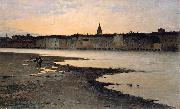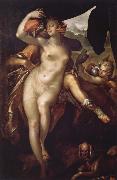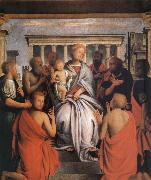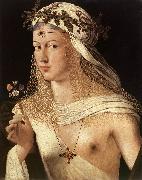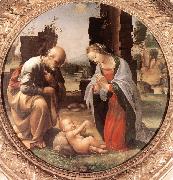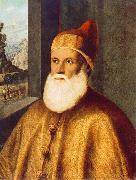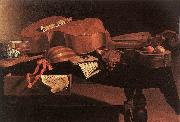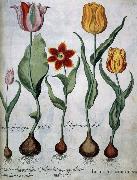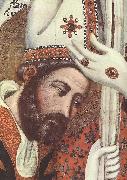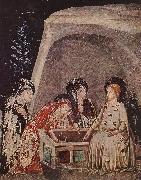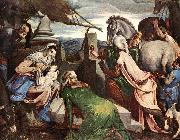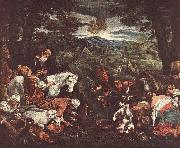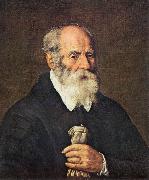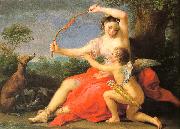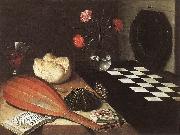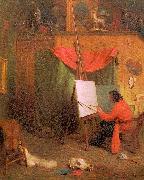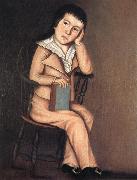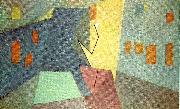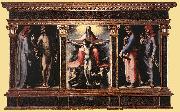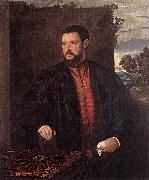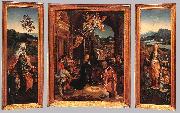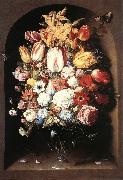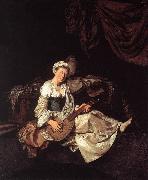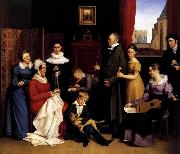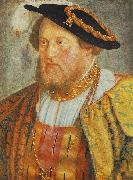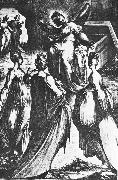|
|
|
|
|
|
 |
Bartolomeo Caporali
|
|
(c. 1420-c. 1505 ; active 1454-1499) was an Italian painter born and active in Perugia. He painted a Madonna and Saints (1487) for the church of Santa Maria Maddalena at Castiglione del Lago.
|
|
 |
bartolomeo della gatta
|
|
(1448 -1502), born Pietro di Antonio Dei, was an Italian (Florentine) painter, illuminator, and architect. He was the son of a goldsmith. He was a colleague of Fra Bartolommeo. In 1468, Bartolomeo became a monk in the Order of Camaldoli, probably in the Church of Santa Maria degli Angeli in Florence, which his brother Nicolo had already entered. Upon taking holy orders, he changed his name to Bartolomeo. About 1481, he was summoned to Rome where he contributed to the cycle of frescos on the walls of the Sistine Chapel. Bartolomeo eventually became Abbot of San Clemente in Arezzo. He died in 1502 and was buried in the Abbey of San Clemente.
|
|
|
|
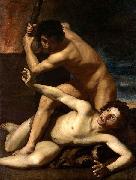 |
Bartolomeo Manfredi
|
|
(baptised 25 August 1582 - 12 December 1622) was an Italian painter, a leading member of the Caravaggisti (followers of Michelangelo Merisi da Caravaggio) of the early 17th century.
Manfredi was born in Ostiano, near Cremona. He may have been a pupil of Caravaggio in Romeat his famous libel trial in 1603 Caravaggio mentioned that a certain Bartolomeo, accused of distributing scurrilous poems attacking Caravaggio's detested rival Baglione, had been a servant of his. Certainly the Bartolomeo Manfredi known to art history was a close follower of Caravaggio's innovatory style, with its enhanced chiaroscuro and insistence on naturalism, with a gift for story-telling through expression and body-language.
Caravaggio in his brief careerehe rocketed to fame in 1600, was exiled from Rome in 1606, and was dead by 1610 had a profound effect on the younger generation of artists, particularly in Rome and Naples. And of these Caravaggisti (followers of Caravaggio), Manfredi seems in turn to have been the most influential in transmitting the master's legacy to the next generation, particularly with painters from France and the Netherlands who came to Italy. Unfortunately no documented, signed works by Manfredi survive, and several of the forty or so works now attributed to him were formerly believed to be by Caravaggio. The steady disentangling of Caravaggio from Manfredi has made clear that it was Manfredi, rather than his master, who was primarily responsible for popularising low-life genre painting among the second generation of Caravaggisti.
Manfredi was a successful artist, able to keep his own servant before he was thirty years old, "a man of distinguished appearance and fine behaviour" according to the biographer Giulio Mancini, although seldom sociable. He built his career around easel paintings for private clients, and never pursued the public commissions upon which wider reputations were built, but his works were widely collected in the 17th century and he was considered Caravaggio's equal or even superior. His Mars Chastising Cupid offers a tantalising hint at a lost Caravaggio: the master promised a painting on this theme to Mancini, but another of Caravaggio's patrons, Cardinal Francesco Maria Del Monte, had taken it, and Mancini therefore commissioned Manfredi to paint another for him, which Mancini considered Manfredi's best work.
Manfredi died in Rome in 1622. Gerard Seghers (or Segers; 1589-1651) was one of his pupils
|
|
|
|
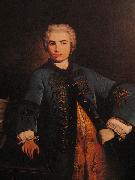 |
Bartolomeo Nazari
|
|
Bartolomeo Nazari (May 31, 1693 - August 24, 1758) was an Italian painter of the late-Baroque, mainly active in Venice as a portraitist.
Born in Clusone, near Bergamo. By 1716, he had become an apprentice under Angelo Trevisani, but visited in 1723 the Roman studio of Angelo's brother, the Venetian Francesco Trevisani, and then also studied with Benedetto Luti. Nazari likely knew personally Fra Galgario, the renowned portraitist from Bergamo, and is described by some as a pupil. He returns to Venice in 1724, and is registered with the Fraglia dei Pittori by 1726. In 1744, he traveled to Frankfurt to paint the emperor Charles VII and his family and other members of the court. In 1756, he was inducted into the newly founded Accademia of Venice. His son Nazario Nazari was also a painter. Among his patrons was Consul Joseph Smith and the former general Johann Matthias von der Schulenburg (who owned over eight diverse portrait paintings). He painted the portraits of a number of operatic singers including Farinelli. He died returning from Genoa, where he had painted the Doge. |
|
 |
Bartolomeo Passerotti
|
|
(1529-1592) was an Italian painter of the mannerist period, who worked mainly in his native Bologna.
He traveled to Rome in the mid-16th century, where he worked under Girolamo Vignola and Taddeo Zuccari. Upon returning to Bologna, he accumulated a large studio, and influenced many Bolognese who would later play a role in the rise of the Baroque. Annibale Carracci (whose brother Agostino studied with Passarotti) was influenced by Passarotti's genre scenes in a select set of paintings (such as The Beaneater and The Butcher's Shop, the latter being originally attributed to Passarotti). Lucio Massari and Francesco Brizzi were among his pupils. Four of Passarotti's sons, including Ventura, Aurelio, Tiburzio, and Passarotto were painters.
|
|
|
|
|
|
|
|
|
|
|
|
|
|
|
|
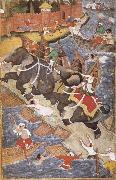 |
Basawan
|
|
Indian Miniaturist, active ca.1556-1600 |
|
|
|
|
|
|
|
|
|
|
|
|
|
|
|
|
|
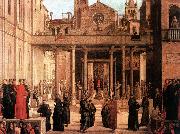 |
BASTIANI, Lazzaro
|
|
Italian painter, Venetian school (b. 1449, Venezia, d. 1512, Venezia) |
|
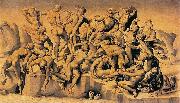 |
Bastiano da Sangallo
|
|
(1481 - May 31, 1551) was an Italian sculptor and painter of the Renaissance period, active mainly in Tuscany. He was a nephew of Giuliano da Sangallo and Antonio da Sangallo the Elder. He is usually known as Aristotile, a nickname he received from his air of sententious gravity. He was at first a pupil of Perugino, but afterwards became a follower of Michelangelo. Mentioned by Vasari as one who made a small copy of the Cartoon of Michelangelo Battle of Cascina (1506).
|
|
|
|
|
|
|
|
|
|
 |
Bazille, Frdric
|
|
Studied under Charles Gleyre.
French Impressionist Painter, 1841-1870
|
|
|
|
|
|
|
|
 |
Beaux, Cecilia
|
|
Studied under Bouguereau and Tony Robert-Fleury.
Specializes in Portraits.
American Painter, 1855-1942
|
|
|
|
|
|
|
|
|
|
|
|
|
|
|
|
|
|
|
|
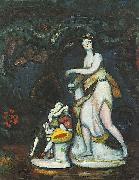 |
Bela Ivanyi-Grunwald
|
|
(6 May 1867 - 24 September 1940) was a Hungarian painter, a leading member of the Nagybenya artists' colony and founder of the Kecskemet artists' colony.
Born in Som, Ivenyi-Grenwald began his artistic studies under Bertalan Szekely and Keroly Lotz at the Academy of Fine Arts in Budapest (1882-86) and continued them at Munich in 1886-87 and at the Academie Julian in Paris from 1887 to 1890. From 1891 he again worked in Munich; in 1894 he travelled with Ferenc Eisenhut to Egypt, where he painted several oriental-themed works. Beginning in 1889 he had regular exhibitions at the Palace of Art in Budapest. Characteristic of his early pictures is A Hader kardja ("The Warrior's Sword", 1890), a proto-Symbolist treatment of rural genre showing the influence of Jules Bastien-Lepage. After his return to Munich, Ivenyi-Grenwald painted a large-scale genre painting entitled Nihilistek sorsot heznak ("Nihilists Drawing Lots", 1893), a work as notable for its dramatic use of chiaroscuro as for its deeply felt subject-matter. In response to a state commission for the 1896 Millennium Exhibition in Budapest he produced an enormous academic history painting. |
|
|
|
|
|
|
|
|
|
|







